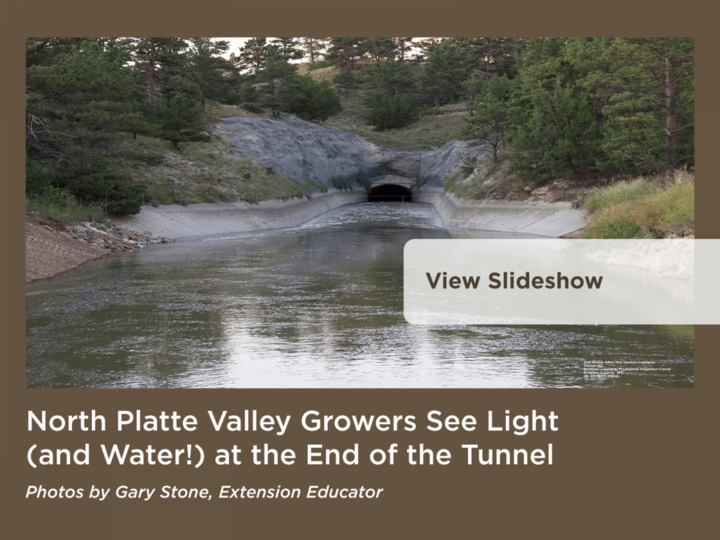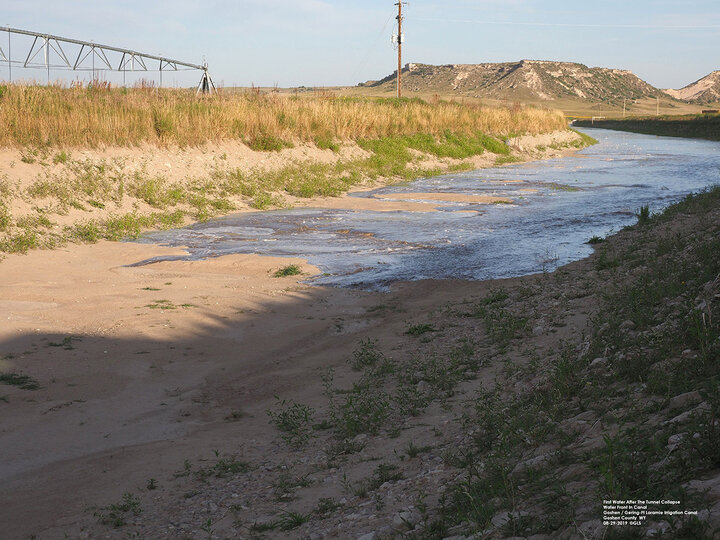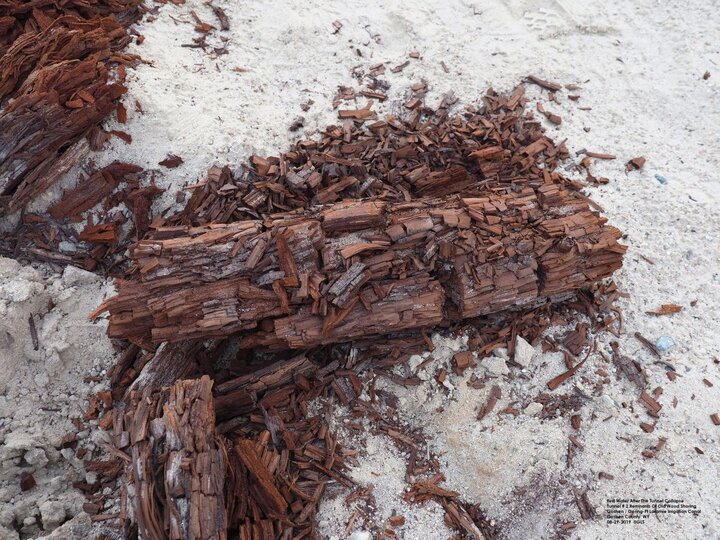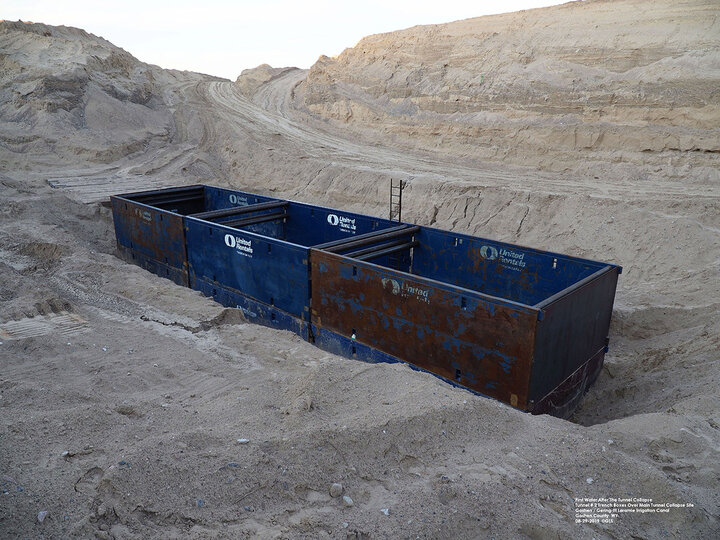
-

Figure 1. Water front of the first water being re-introduced into the Goshen / Gering-Ft Laramie Irrigation District canal August 28 after the tunnel and canal bank repairs.
-

Figure 2. First water at the repair site of canal bed and canal bank breach that occurred on July 17, 2019.
-

Figure 3. First water at the entrance to Tunnel 2 on the Goshen / Gering-Ft Laramie Irrigation District canal. Flow rate in the canal is 600 cfs at this point.
-

Figure 4. Remnants of some of the timber structure used in the original construction of the tunnel in 1917. -

Figure 5. Trench boxes were installed above the tunnel to keep additional soil from entering the tunnel through the main collapse site. These boxes are 10 feet high, 20 feet wide, and 20 feet long. Three sections are joined together and placed one on top of the other.
-

Water began flowing in the Gering-Fort Laramie and Goshen irrigation canal early Aug. 28 for the first time in about six weeks. Tunnel No. 2 on the main supply canal collapsed on July 17, causing a canal breach and disrupting service to more than 100,000 acres of irrigated crops in Scotts Bluff County, Nebraska, and Goshen County, Wyoming.
Around 6 p.m. Wednesday, Aug. 28, the Goshen Irrigation District (GID) released water from Whalen Diversion Dam on the North Platte River west of Fort Laramie, Wyoming, into the Goshen / Gering-Ft Laramie irrigation canal. The diversion was approximately 600 cubic feet per second (CFS), or 269,280 gallons per minute. The water front reached Tunnel No. 2 entrance around 3:30 a.m. Thursday, Aug. 29. GID and U.S. Bureau of Reclamation personnel were on site to observe any leaks in the newly constructed canal bank and bed.
The volume of water in the canal was to be gradually increased to a flow rate of 800 cfs (359,040 gallons per minute) and monitored over the 24 hours following the first releases. If there were no problems after another 24 hours, the flow rate was to be increased to 1,000 cfs (448,800 gallons per minute). At this time, there is no indication when growers under the irrigation districts can start to take water for their fields. It will take approximately 5 days for the water to travel the 130 miles of main canal.
Prior to the release of water into the canal, trench boxes were put in place above the tunnel to keep additional soil from entering the tunnel through the main collapse site. These boxes are 10 feet high, 20 feet wide and 20 feet long. Three sections are joined together and placed one on top of the other.
The main tunnel collapse site/hole has not repaired. It is shored up to prevent more soil from entering the tunnel. Contractors removed most of the soil from the tunnel, leaving a small amount of soil on the bottom. This soil will be flushed out by the water flowing through the tunnel. The main tunnel collapse site was not repaired at this time as it was more important to get water flowing again in the canal system. Once the 2019 irrigation season has passed, a more permanent fix will be determined. Both irrigation districts are working on long-term solutions and funding for all three tunnel structures on the canal system.
There is still much work to do, and many challenges facing the affected farmers and communities, but the irrigators and everyone else can literally see the light at the end of the tunnel.
Nebraska Extension and the University of Wyoming Extension have been working together to share information and help growers in both states understand their options during this severe situation. See their website at go.unl.edu/canal
Please see https://cropwatch.unl.edu/tags/canal-irrigation for additional stories.
For more information on the North Platte River and the irrigation projects in Nebraska and Wyoming, visit the slideshare presentation on the University of Nebraska Panhandle Research and Extension Center web site.
Time-Lapse Videos of Crops Affected by Canal Shut-Off
Videos from time-lapse cameras on several field affected by the tunnel collapse, showing crop condition in the days and weeks following the loss of irrigation water. Cameras operated and videos edited by Nebraska Extension Cropping Systems Educator John Thomas.
Time-lapse video of a corn field in Scotts Bluff County, NE, affected by the July 17 failure of the Fort Laramie Irrigation Canal and tunnel. Camera was set up by Cropping Systems Educator John Thomas of Nebraska Extension. John’s report: The corn that only received one irrigation this season due to the canal failure continues to look better than expected due to a cooler summer, high humidity and some rain. The rain on August 20 and 21 (1.5 inches) was very helpful and was accompanied by a light hail doing minor damage. Notice some leaf curling in the afternoons before August 20th. Not all crops in the area of the irrigation failure are doing this well. Time-lapse video of a dry edible bean field in Scotts Bluff County, NE, affected by the July 17 failure of the Fort Laramie Irrigation Canal and tunnel. Camera was set up by Cropping Systems Educator John Thomas of Nebraska Extension. John’s report: The dry beans that received no irrigation this season due to the canal failure continue to look better than expected due to a cooler summer, high humidity and some rain. The plants have flowered and have a reasonable pod set. The rain on August 20 and 21 (1.5 inches) was very helpful and was accompanied by a light hail doing minor damage. Not all crops in the area of the irrigation failure are doing this well. Time-lapse video of a sugarbeet field in Scotts Bluff County, NE, affected by the July 17 failure of the Fort Laramie Irrigation Canal and tunnel. Camera was set up by Cropping Systems Educator John Thomas of Nebraska Extension. John’s report: The sugar beets only received one irrigation this season due to the canal failure. They continue to look better than expected due to a cooler summer, high humidity and some rain. The rain on August 20 and 21 (1.5 inches) was very helpful and was accompanied by a light hail doing minor damage. Notice the afternoon leaf wilting before the rain on August 20th. Not all crops in the area of the irrigation failure are doing this well.//
